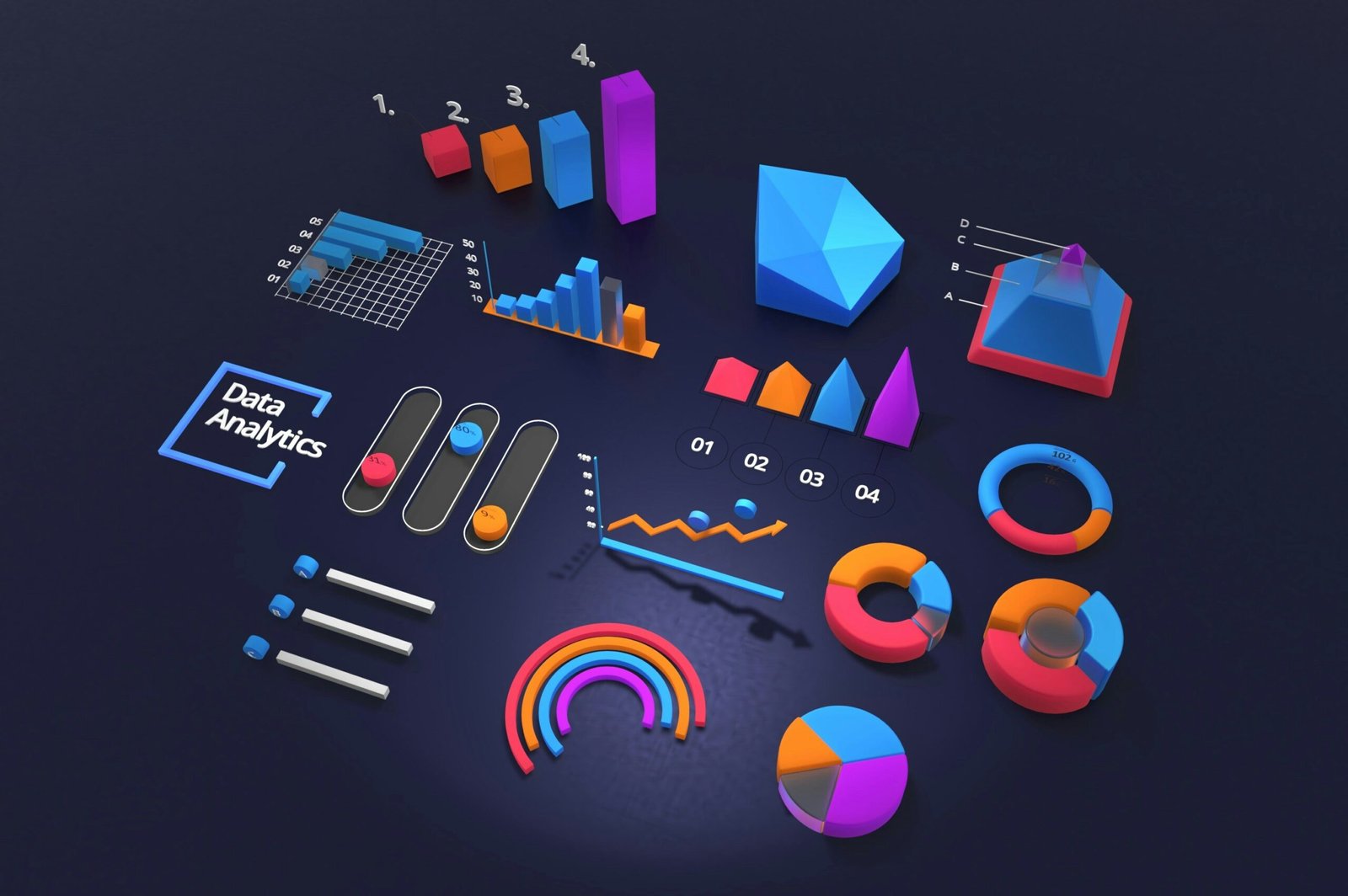
Introduction to Big Data Analytics
Big data analytics has emerged as a crucial discipline in today’s increasingly data-driven world. The term “big data” refers to the vast volumes of structured and unstructured data generated from various sources, including social media, sensors, transactions, and more. This unprecedented data growth brings both challenges and opportunities for organizations across different sectors. As businesses strive to remain competitive, they must navigate the complexities of analyzing large datasets to derive actionable insights.
One of the primary challenges associated with big data analytics is the sheer volume of information. Traditional data processing systems often struggle to manage, store, and analyze the large quantities of data involved. Additionally, the velocity at which data is generated can hinder timely analysis. Organizations must also contend with data variety, as data can come in multiple formats, from text and images to video and logs. These factors necessitate advanced analytical tools that can handle diverse datasets while providing swift and reliable results.
Despite these challenges, big data analytics opens up numerous opportunities for improving decision-making, enhancing operational efficiency, and driving innovation. By leveraging sophisticated analytical techniques, organizations can uncover trends, identify patterns, and gain insights that were previously unattainable. This process is significantly facilitated by the role of data science, which employs statistical methods, machine learning, and predictive modeling to explore and interpret large datasets.
As organizations recognize the value of data-driven insights, the need for proficient data science tools becomes increasingly essential. In understanding the landscape of big data analytics, one must consider the tools available in 2024 that can help unlock the potential of big data, allowing businesses to transform raw information into strategic advantages.
The Evolution of Data Science Tools
The landscape of data science tools has significantly evolved over the past several decades, driven by the increasing volume and complexity of data. In the early days of data analysis, tools were often basic, limited in functionality, and primarily designed for structured data. Software such as Excel and early statistical packages laid the groundwork for data manipulation and visualization. However, as organizations began to recognize the potential of data-driven decision-making, the introduction of more robust analytical tools became necessary.
By the late 2000s, as big data started to emerge, the tools used for data science underwent a transformative shift. Open-source programming languages like R and Python gained prominence, providing data scientists with powerful libraries for data manipulation, statistical analysis, and machine learning. This evolution marked a move away from proprietary software towards more collaborative and accessible frameworks, allowing data scientists to leverage community contributions and faster iteration cycles.
The introduction of distributed computing frameworks, such as Apache Hadoop and Apache Spark, further revolutionized the data science toolkit by enabling the processing of large-scale data sets over clusters of machines. These technologies facilitated an increased focus on big data analytics, allowing organizations to analyze data in real-time and derive insights at unprecedented scales.
Moreover, the transition from on-premises solutions to cloud-based platforms marked another significant milestone in the evolution of data science tools. Cloud computing offered scalability, flexibility, and cost-effectiveness, enabling businesses of all sizes to access advanced analytics without the burden of maintaining extensive IT infrastructure. In recent years, the integration of artificial intelligence and machine learning into analytics tools has made it possible for organizations to automate complex data analysis tasks, making data science more efficient and user-friendly.
As we move into 2024, the evolution of data science tools continues to accelerate, driven by emerging technologies and the growing need for sophisticated big data analytics solutions. The future of these tools promises greater integration of AI capabilities, enabling data scientists to glean more actionable insights from vast datasets with efficiency and precision.
Key Features to Look for in Data Science Tools
In the rapidly evolving field of big data analytics, the selection of appropriate data science tools becomes crucial for organizations aiming to leverage data-driven insights. Numerous tools are available, yet several key features significantly impact their effectiveness. Among these, scalability is paramount. In the context of big data, scalability refers to the tool’s ability to handle increasing amounts of data efficiently. As organizations grow, their data volume increases, hence the need for tools that can expand in capacity without a decline in performance.
User-friendliness is another essential attribute of data science tools. The complexity of big data can be overwhelming; therefore, tools that offer intuitive interfaces enhance usability for both novice and experienced data scientists. This characteristic enables teams to quickly adapt and reduces the learning curve associated with new technologies.
Integration capabilities should not be overlooked either. Effective data science tools must seamlessly integrate with existing systems and databases. This facilitates smooth data transfer and enhances collaborative efforts among diverse teams working towards shared objectives. Furthermore, tools that support a variety of machine learning algorithms are indispensable. These algorithms enable predictive analytics, which unlocks the potential of data by providing actionable insights based on historical patterns.
Real-time data processing also emerges as a critical feature in modern data science tools. As businesses strive for agility, the ability to analyze data in real time allows for quicker decision-making and enhances responsiveness to market changes. With these essential features—scalability, user-friendliness, integration capabilities, support for machine learning, and real-time processing—data science tools play a pivotal role in the success of big data analytics efforts.
Top Data Science Tools for Big Data Analytics in 2024
As we step into 2024, the landscape of data science tools continues to evolve, facilitating more sophisticated big data analytics. Among the most prominent tools available this year are Apache Spark, Tableau, and TensorFlow, which provide diverse functionalities for both novice and experienced data scientists.
Apache Spark remains a leading choice for large-scale data processing, offering an in-memory computing capability that enhances performance compared to traditional disk-based processing. Its flexibility allows it to integrate with various data storage systems, such as Hadoop and NoSQL databases, making it ideal for organizations that need to process terabytes of data efficiently. Additionally, Spark supports multiple languages, including Scala, Python, and R, appealing to a broad audience of data professionals.
Another noteworthy tool is Tableau, which has solidified its position as a premier data visualization platform. In 2024, Tableau continues to be favored for its user-friendly interface and robust analytical capabilities. It provides real-time data analysis and a wide range of visualization options, allowing teams to create insightful dashboards effortlessly. Tableau’s ability to connect with numerous data sources enhances its versatility, catering to industries seeking to derive actionable insights from complex datasets.
For those engaged in machine learning and deep learning, TensorFlow stands out due to its powerful capabilities in building and training neural networks. Its adaptability allows for deployment across various platforms, including cloud and mobile. TensorFlow’s extensive library of pre-built models and tools streamlines the development process, making it an essential resource for data scientists aiming to implement advanced predictive analytics.
In essence, these tools—Apache Spark for data processing, Tableau for visualization, and TensorFlow for machine learning—each serve distinct purposes while collectively empowering organizations to navigate and leverage big data analytics effectively. The right tool depends largely on the specific needs and goals of the data science teams, ensuring that organizations can make data-driven decisions in an increasingly complex digital landscape.
Comparison of Open Source vs. Proprietary Tools
In the realm of big data analytics, organizations often face a pivotal choice between open-source and proprietary tools. Each category brings distinct advantages and disadvantages, leading to varying implications for data management and analysis.
Open-source data science tools are typically available at no cost, promoting accessibility and flexibility. They encourage collaboration and innovation, allowing developers to modify and enhance the software based on their specific needs. Additionally, being community-driven, open-source tools benefit from a diverse pool of contributors who regularly update the software, ensuring it remains relevant and up-to-date. Prominent examples include Apache Hadoop and R, both widely adopted in various industries due to their powerful capabilities and extensive user communities.
On the other hand, proprietary tools, such as Tableau and SAS, often come with substantial initial costs. These tools usually offer dedicated customer support and robust documentation, which can be essential for organizations lacking in-house expertise. Proprietary solutions may provide advanced features and intuitive interfaces, offering a more streamlined user experience. However, their closed nature can limit customization, leaving organizations reliant on the vendor for updates and functionalities.
Organizations must weigh these considerations based on their specific big data needs. For instance, a startup with tight budgets may prefer the flexibility of open-source tools, while a large enterprise might opt for proprietary solutions, valuing the support and reliability they provide. Additionally, the trade-offs often influence the decision-making process; companies may choose open-source tools to foster an innovative culture, while those prioritizing security and reliability might lean towards proprietary options.
In summary, the choice between open-source and proprietary data science tools hinges on an organization’s unique requirements, including budget constraints, desired level of support, and the need for customizability in big data analytics.
Implementation Challenges and Best Practices
Implementing data science tools for big data analytics can be a complex process that organizations frequently encounter. One predominant challenge involves ensuring data quality. Inaccurate, inconsistent, or incomplete data can significantly skew analytics outcomes, leading to misguided business decisions. Establishing robust data governance frameworks is essential to maintain data integrity and enhance overall analytics effectiveness.
Another frequent obstacle arises from the integration of new tools with existing systems. Many organizations rely on legacy systems that may not be compatible with the latest data science technologies. As a result, integrating these tools can lead to operational disruptions and increased costs. To mitigate these issues, organizations should assess their current IT infrastructure and adopt a phased approach to integration. This may include investing in middleware solutions that facilitate seamless communication between new and existing systems.
Furthermore, skill gaps within teams can pose a significant barrier to the successful implementation of data science tools. As the demand for data literacy increases, many teams may find themselves lacking the necessary skills to fully leverage advanced data analytics tools. To address this, organizations should prioritize training and development initiatives that enhance the technical skills of their employees. Collaborating with educational institutions for specialized courses or developing in-house training programs can help bridge the knowledge gap.
Best practices for overcoming these challenges include fostering a culture of collaboration and continuous improvement. Engaging stakeholders from various departments can provide valuable insights and create a sense of ownership around the data initiatives. Regularly reviewing tools and practices will allow organizations to adapt to changing data landscapes effectively. By addressing data quality, facilitating integration, and developing team competencies, organizations can navigate the challenges related to data science tool implementation successfully.
Future Trends in Data Science Tools
As we look towards the future of data science tools, several key trends are emerging that are poised to reshape the landscape of big data analytics. One of the most significant advancements is the rise of automated machine learning (AutoML). This technology empowers data scientists and business analysts alike by streamlining the model development process, allowing users to conduct sophisticated analyses without requiring deep technical expertise. AutoML democratizes access to machine learning capabilities, which may lead to increased adoption across various industries in 2024 and beyond.
Another noteworthy trend is the proliferation of no-code and low-code platforms. These user-friendly interfaces are designed to facilitate data analysis and machine learning for individuals without extensive programming skills. As organizations strive to harness the potential of big data, no-code solutions are expected to attract a broader audience, enabling more professionals to build data-driven applications and insights without needing to learn complex coding languages. This shift could substantially accelerate data science projects and initiatives across various sectors.
Moreover, the integration of artificial intelligence and enhanced machine learning features into existing data science tools is becoming increasingly critical. As organizations generate and collect more data, the demand for tools that can effectively process and derive insights from vast datasets is growing. Data analytics platforms equipped with machine learning capabilities will play a pivotal role in predicting trends, generating forecasts, and providing actionable insights. This integration not only improves efficiency but also enhances the accuracy of analyses, making data science tools indispensable in the evolving landscape of big data analytics.
The convergence of these trends suggests a future where data science and analytics are more accessible and integrated across diverse organizational practices. Organizations that leverage these evolving tools are likely to gain a competitive edge in their respective industries as they navigate the complexities of big data.
Case Studies: Successful Use of Data Science Tools
In the realm of big data analytics, numerous organizations have harnessed the power of data science tools to overcome challenges and achieve remarkable results. A notable example is Netflix, which employs machine learning algorithms and data science tools such as Apache Spark for big data processing. Faced with the challenge of content personalization, Netflix utilized these tools to analyze vast amounts of viewer data. Consequently, this led to increased user engagement and retention, demonstrating the effectiveness of tailored content recommendations based on individual preferences.
Another prominent case is that of Walmart, one of the largest retail corporations globally. Walmart uses advanced analytics tools like Hadoop and Scala to manage and analyze customer transactions in real-time, allowing for data-driven decision-making. One significant challenge that Walmart faced was managing inventory across its numerous stores while ensuring customer satisfaction. By leveraging data science tools, Walmart implemented predictive analytics to forecast sales and optimize inventory levels. This strategic approach not only reduced operational costs but also improved product availability, enhancing the overall shopping experience for customers.
Additionally, the healthcare sector has seen transformative applications through data science tools. For instance, Mount Sinai Health System adopted Tableau and R for data visualization and predictive analytics in patient care. The organization encountered challenges regarding patient readmission rates and treatment efficacy analysis. By employing these tools, Mount Sinai could identify patterns and risk factors linked to readmissions, leading to improved patient outcomes. The resulting insights enabled healthcare professionals to implement personalized care approaches, ultimately contributing to better health management and resource allocation.
These case studies illuminate the diverse ways that organizations have successfully integrated data science tools into their analytics practices. Each example serves to inspire other companies seeking to enhance their own analytics capabilities, ultimately driving operational efficiency and improved decision-making.
Conclusion and Takeaways
As we have explored throughout this blog post, the landscape of data science tools for big data analytics in 2024 is rich and diverse. The rise of advanced technologies and methodologies has made it necessary for data professionals to continuously assess and incorporate the best tools available. An effective analytics strategy begins with selecting the right data science tools that align with specific project requirements, offering scalability, ease of use, and robust functionalities.
Throughout our discussion, we highlighted several essential data science tools that have garnered attention for their capabilities and features. Tools such as Apache Spark, Hadoop, and various machine learning libraries provide significant advantages in processing large datasets, facilitating quicker and more accurate insights. Additionally, cloud-based solutions have emerged as powerful alternatives, enhancing accessibility and collaboration among teams while streamlining processes.
It is crucial to recognize that the field of data science is continually evolving. As new challenges and opportunities arise, data professionals must remain agile and informed about the latest developments in technology and analytics. Continuous education, training, and adaptation will be instrumental in employing the most effective data science tools and methodologies. Furthermore, remaining open to experimenting with new tools will enable analysts to uncover unique insights, thus enhancing their overall effectiveness in the rapidly changing landscape of big data analytics.
In conclusion, selecting the right data science tools for big data analytics is imperative for any organization aiming to harness the full potential of their data. By keeping abreast of advancements and adapting accordingly, organizations will be better positioned to navigate the complexities of data science, ensuring sustained growth and success in the years to come.

